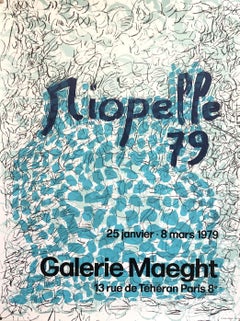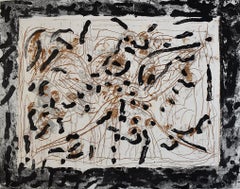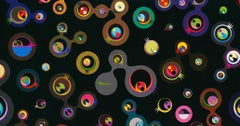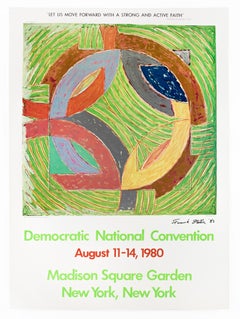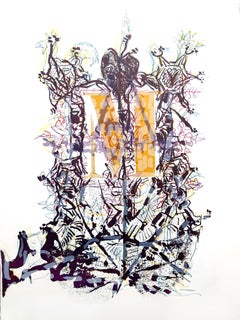Jean-Paul Riopelle More Prints
Canadian, 1923-2002
Jean-Paul Riopelle (1923 – 2002) was a painter and sculptor from Quebec, Canada. He became the first Canadian painter (since James Wilson Morrice) to attain widespread international recognition. Born in Montreal, Riopelle began drawing lessons in 1933 and continued through 1938. He studied engineering, architecture and photography at the ecole polytechnique in 1941. In 1942 he enrolled at the Ecole des Beaux-Arts de Montreal but shifted his studies to the less academic Ecole du Meuble, graduating in 1945. He studied under Paul-Emile Borduas in the 1940s and was a member of Les Automatistes movement. Breaking with traditional conventions in 1945 after reading Andre Breton's Le Surrealisme et la Peinture, he began experimenting with non-objective (or non-representational) painting. He was one of the signers of the Refus global manifesto. In 1947 Riopelle moved to Paris and continued his career as an artist, where, after a brief association with the surrealists (he was the only Canadian to exhibit with them) he capitalized on his image as a "wild Canadian". His first solo exhibition took place in 1949 at the Surrealist meeting place, Galerie La Dragonne in Paris.
In 1959 he began a relationship with the American painter Joan Mitchell. Living together throughout the 1960s, they kept separate homes and studios near Giverny, where Monet had lived. They influenced one another greatly, as much intellectually as artistically, but their relationship was a stormy one, fueled by alcohol. The relationship ended in 1979. His 1992 painting Hommage a Rosa Luxemburg is Riopelle's tribute to Mitchell, who died that year, and is regarded as a high point of his later work. Riopelle's style in the 1940s changed quickly from Surrealism to Lyrical Abstraction (related to abstract expressionism), in which he used myriad tumultuous cubes and triangles of multicolored elements, facetted with a palette knife, spatula, or trowel, on often large canvases to create powerful atmospheres. The presence of long filaments of paint in his painting from 1948 through the early 1950s has often been seen as resulting from a dripping technique like that of Jackson Pollock. Rather, the creation of such effects came from the act of throwing, with a palette knife or brush, large quantities of paint onto the stretched canvas (positioned vertically). Riopelle's voluminous impasto became just as important as color.
Riopelle was arguably one of the most important Canadian artists of the 20th century, establishing his reputation in the burgeoning postwar art scene of Paris, where his entourage included Andre Breton, Sam Francis and Samuel Beckett. Riopelle produced over six thousand works (of which he produced more than two thousand paintings) during the course of his lifetime.to
2
Overall Width
to
Overall Height
to
1
60
689
454
220
158
2
1
1
1
1
1
1
1
1
1
1
Artist: Jean-Paul Riopelle
Canadian Post Modern Pop Art Lithograph Vintage Poster Memphis Galerie Maeght
By Jean-Paul Riopelle
Located in Surfside, FL
Vintage gallery exhibition poster.
The Galerie Maeght is a gallery of modern art in Paris, France, and Barcelona, Catalonia, Spain. The gallery was founded in 1936 in Cannes. The Paris gallery was started in 1946 by Aimé Maeght. The artists exhibited are mainly from France and Spain. Since 1945, the gallery has presented the greatest modern artists such as Matisse, Bonnard, Braque, Miró, and Calder. In 1956, Adrien Maeght opened a new parisian venue. The second generation of “Maeght” artists was born: Bazaine, Andre Derain, Giacometti, Kelly, Raoul Ubac, then Riopelle, Antoni Tapies, Pol Bury and Adami, among others.
Jean-Paul Riopelle, CC GOQ (7 October 1923 – 12 March 2002) was a painter and sculptor from Quebec, Canada. He became the first Canadian painter (since James Wilson Morrice) to attain widespread international recognition.
Born in Montreal, Riopelle began drawing lessons in 1933 and continued through 1938. He studied engineering, architecture and photography at the école polytechnique in 1941. In 1942 he enrolled at the École des beaux-arts de Montréal but shifted his studies to the less academic école du Meuble, graduating in 1945.
He studied under Paul-Émile Borduas in the 1940s and was a member of Les Automatistes movement. Breaking with traditional conventions in 1945 after reading André Breton's Le Surréalisme et la Peinture, he began experimenting with non-objective (or non-representational) painting. He was one of the signers of the Refus global manifesto. In 1947 Riopelle moved to Paris and continued his career as an artist, where, after a brief association with the surrealists (he was the only Canadian to exhibit with them) he capitalized on his image as a "wild Canadian". His first solo exhibition took place in 1949 at the Surrealist meeting place, Galerie La Dragonne in Paris. Riopelle married Françoise Lespérance in 1946; the couple had two daughters but separated in 1953. In 1959 he began a relationship with the American painter Joan Mitchell, Living together throughout the 1960s, they kept separate homes and studios near Giverny, where Monet had lived. They influenced one another greatly, as much intellectually as artistically, but their relationship was a stormy one, fueled by alcohol. The relationship ended in 1979. His 1992 painting Hommage à Rosa Luxemburg is Riopelle's tribute to Mitchell, who died that year, and is regarded as a high point of his later work.
Riopelle's style in the 1940s changed quickly from Surrealism to Lyrical Abstraction (related to abstract expressionism), in which he used myriad tumultuous cubes and triangles of multicolored elements, facetted with a palette knife, spatula, or trowel, on often large canvases to create powerful atmospheres. The presence of long filaments of paint in his painting from 1948 through the early 1950s[8] has often been seen as resulting from a dripping technique like that of Jackson Pollock. Rather, the creation of such effects came from the act of throwing, with a palette knife or brush, large quantities of paint onto the stretched canvas.
Riopelle's voluminous impasto became just as important as color. His oil painting technique allowed him to paint thick layers, producing peaks and troughs as copious amounts of paint were applied to the surface of the canvas. Riopelle, though, claimed that the heavy impasto was unintentional: "When I begin a painting," he said, "I always hope to complete it in a few strokes, starting with the first colours I daub down anywhere and anyhow. But it never works, so I add more, without realizing it. I have never wanted to paint thickly, paint tubes are much too expensive. But one way or another, the painting has to be done. When I learn how to paint better, I will paint less thickly."
When Riopelle started painting, he would attempt to finish the work in one session, preparing all the color he needed before hand: "I would even go as far to say—obviously I don't use a palette, but the idea of a palette or a selection of colors that is not mine makes me uncomfortable, because when I work, I can't waste my time searching for them. It has to work right away."
A third element, range of gloss, in addition to color and volume, plays a crucial role in Riopelle's oil paintings. Paints are juxtaposed so that light is reflected off the surface not just in different directions but with varying intensity, depending on the naturally occurring gloss finish (he did not varnish his paintings). These three elements; color, volume, and range of gloss, would form the basis of his oil painting technique throughout his long and prolific career.
Riopelle received an Honorable Mention at the 1952 São Paulo Art Biennial. In 1953 he showed at the Younger European Painters exhibition at the Solomon R. Guggenheim Museum in New York City. The following year Riopelle began exhibiting at the Pierre Matisse Gallery in New York. In 1954, works by Riopelle, along with those of B. C. Binning and Paul-Émile Borduas represented Canada at the Venice Biennale. He was the sole artist representing Canada at the 1962 Venice Biennale in an exhibit curated by Charles Comfort...
Category
1970s Pop Art Jean-Paul Riopelle More Prints
Materials
Lithograph, Offset
Composition I, from: Marrying Flies Les mouches à marier - Canadian
By Jean-Paul Riopelle
Located in London, GB
This work is hand signed in pencil by the artist "Riopelle" at the lower right corner.
It is also hand inscribed in pencil "EA" (épreuve d’artiste), at the lower left corner.
This i...
Category
1980s Jean-Paul Riopelle More Prints
Materials
Etching, Aquatint
Related Items
Takashi Murakami Kanye West 2007 (Takashi Murakami Louis Vuitton)
By Takashi Murakami
Located in NEW YORK, NY
Takashi Murakami, Kanye West, Louis Vuitton; Los Angeles 2007 (Murakami Gala):
Rare folding invitation published on the occasion of a 2007 reception honoring Takashi Murakami and fashion icon Marc Jacobs with a special performance by Kanye West; October 28th, 2007; MOCA Los Angeles; hosted by Louis Vuitton. Front side imagery features a reproduction of Murakami’s ‘Jellyfish...
Category
21st Century and Contemporary Pop Art Jean-Paul Riopelle More Prints
Materials
Offset, Paper
SIGNED Frank Stella poster 1980 Democratic Convention colorful vintage Pop
By Frank Stella
Located in New York, NY
Colorful vintage poster for the 1980 Democratic National Convention, held in Madison Square Garden in New York.Concentric lines of orange and bright green interweave with strokes of ...
Category
1980s Pop Art Jean-Paul Riopelle More Prints
Materials
Lithograph
Nara Girl Banging On A Drum With Limited Edition Sticker Set Pop Art Print
By Yoshitomo Nara
Located in Draper, UT
Banging the Drum
DETAILS
27 x 17 inches (unframed), 2020
Offset lithograph
80# Classic Linen Solar White Cover
Category
2010s Pop Art Jean-Paul Riopelle More Prints
Materials
Lithograph
Takashi Murakami record art 2018 (Takashi Murakami Kanye West)
By Takashi Murakami
Located in NEW YORK, NY
Takashi Murakami Record Art 2018 (Takashi Murakami Kanye West Kid Cudi):
This Takashi Murakami designed cover & record album is for Kids See Ghosts and is the only studio album by t...
Category
21st Century and Contemporary Pop Art Jean-Paul Riopelle More Prints
Materials
Paper, Offset
Robert Rauschenberg, rare 1970s Signed/N Earth Day William Burroughs lithograph
By Robert Rauschenberg
Located in New York, NY
ROBERT RAUSCHENBERG
Dream of William Burroughs, 1972
Offset lithograph
34 1/2 × 24 inches
Edition 103/150
Signed, dated and numbered in black marker on the front
Unframed
Wonderful e...
Category
1970s Pop Art Jean-Paul Riopelle More Prints
Materials
Lithograph, Offset
Takashi Murakami 'Superflat' exhibition poster (vintage Takashi Murakami)
By Takashi Murakami
Located in NEW YORK, NY
Takashi Murakami Superflat Exhibition Poster 1999:
Rare 1990s exhibit poster designed by Murakami and published by Marianne Boesky Gallery New York...
Category
21st Century and Contemporary Pop Art Jean-Paul Riopelle More Prints
Materials
Lithograph, Offset
$375 Sale Price
31% Off
H 22 in W 17 in D 0.01 in
Suckers State I
By Wayne Thiebaud
Located in New York, NY
A very good impression of this lithograph on Rives BFK. Signed, inscribed "state I" and numbered 111/150 in pencil. Printed and published by Gemini G.E.L., Los Angeles, with the blin...
Category
1960s Pop Art Jean-Paul Riopelle More Prints
Materials
Lithograph
Old Rinkrank threatens the Princess by David Hockney Brothers Grimm Fairy Tales
By David Hockney
Located in New York, NY
This etching from David Hockney’s celebrated Six Fairy Tales from the Brothers Grimm portfolio depicts the somewhat obscure story Old Rinkrank, which Hockney chose to illustrate beca...
Category
1960s Modern Jean-Paul Riopelle More Prints
Materials
Etching, Aquatint
Vintage James Rosenquist poster MOCA Chicago 1972 neon yellow pink chrome
By James Rosenquist
Located in New York, NY
An inverted car, gleaming in chrome, speeds through sumptuous layers of pink, translucent yellow, and a veil of lacy, flower-like shapes. Across the top, the artist’s name is splashe...
Category
1970s Pop Art Jean-Paul Riopelle More Prints
Materials
Offset
Quarry
By Robert Rauschenberg
Located in Washington, DC
Artist: Robert Rauschenberg
Title: Quarry
Medium: Offset lithograph in colors
Year: 1968
Edition: 500
Frame Size: 41 1/2" x 33"
Sheet Size: 35 1/2" x 26 1/2"
Signature: Signed in the...
Category
1960s Pop Art Jean-Paul Riopelle More Prints
Materials
Lithograph
Study for Sculpture in the Form of an Inverted Q Above and Below Ground
By Claes Oldenburg
Located in New York, NY
This work is a study for Inverted Q, a large sculpture that Oldenburg created after producing many sketches and small models. At the time he was experimenting with concepts of monume...
Category
1970s Pop Art Jean-Paul Riopelle More Prints
Materials
Etching, Aquatint, Lithograph
United Nations Peacekeeping Operations
By Joan Miró
Located in Washington, DC
Artist: Joan MIro
Title: United Nations Peacekeeping Operations
Medium: Lithograph in colors
Date: 1980
Edition: 683/1500
Framed Size: 18 3/4" x 16 1/4"
Sheet Size: 11" x 8 1/2"
Ima...
Category
1970s Pop Art Jean-Paul Riopelle More Prints
Materials
Lithograph
Previously Available Items
Canadian Post Modern Pop Art Lithograph Vintage Poster Memphis Galerie Maeght
By Jean-Paul Riopelle
Located in Surfside, FL
Vintage gallery exhibition poster.
The Galerie Maeght is a gallery of modern art in Paris, France, and Barcelona, Catalonia, Spain. The gallery was founded in 1936 in Cannes. The Paris gallery was started in 1946 by Aimé Maeght. The artists exhibited are mainly from France and Spain. Since 1945, the gallery has presented the greatest modern artists such as Matisse, Bonnard, Braque, Miró, and Calder. In 1956, Adrien Maeght opened a new parisian venue. The second generation of “Maeght” artists was born: Bazaine, Andre Derain, Giacometti, Kelly, Raoul Ubac, then Riopelle, Antoni Tapies, Pol Bury and Adami, among others.
Jean-Paul Riopelle, CC GOQ (7 October 1923 – 12 March 2002) was a painter and sculptor from Quebec, Canada. He became the first Canadian painter (since James Wilson Morrice) to attain widespread international recognition.
Born in Montreal, Riopelle began drawing lessons in 1933 and continued through 1938. He studied engineering, architecture and photography at the école polytechnique in 1941. In 1942 he enrolled at the École des beaux-arts de Montréal but shifted his studies to the less academic école du Meuble, graduating in 1945.
He studied under Paul-Émile Borduas in the 1940s and was a member of Les Automatistes movement. Breaking with traditional conventions in 1945 after reading André Breton's Le Surréalisme et la Peinture, he began experimenting with non-objective (or non-representational) painting. He was one of the signers of the Refus global manifesto. In 1947 Riopelle moved to Paris and continued his career as an artist, where, after a brief association with the surrealists (he was the only Canadian to exhibit with them) he capitalized on his image as a "wild Canadian". His first solo exhibition took place in 1949 at the Surrealist meeting place, Galerie La Dragonne in Paris. Riopelle married Françoise Lespérance in 1946; the couple had two daughters but separated in 1953. In 1959 he began a relationship with the American painter Joan Mitchell, Living together throughout the 1960s, they kept separate homes and studios near Giverny, where Monet had lived. They influenced one another greatly, as much intellectually as artistically, but their relationship was a stormy one, fueled by alcohol. The relationship ended in 1979. His 1992 painting Hommage à Rosa Luxemburg is Riopelle's tribute to Mitchell, who died that year, and is regarded as a high point of his later work.
Riopelle's style in the 1940s changed quickly from Surrealism to Lyrical Abstraction (related to abstract expressionism), in which he used myriad tumultuous cubes and triangles of multicolored elements, facetted with a palette knife, spatula, or trowel, on often large canvases to create powerful atmospheres. The presence of long filaments of paint in his painting from 1948 through the early 1950s[8] has often been seen as resulting from a dripping technique like that of Jackson Pollock. Rather, the creation of such effects came from the act of throwing, with a palette knife or brush, large quantities of paint onto the stretched canvas.
Riopelle's voluminous impasto became just as important as color. His oil painting technique allowed him to paint thick layers, producing peaks and troughs as copious amounts of paint were applied to the surface of the canvas. Riopelle, though, claimed that the heavy impasto was unintentional: "When I begin a painting," he said, "I always hope to complete it in a few strokes, starting with the first colours I daub down anywhere and anyhow. But it never works, so I add more, without realizing it. I have never wanted to paint thickly, paint tubes are much too expensive. But one way or another, the painting has to be done. When I learn how to paint better, I will paint less thickly."
When Riopelle started painting, he would attempt to finish the work in one session, preparing all the color he needed before hand: "I would even go as far to say—obviously I don't use a palette, but the idea of a palette or a selection of colors that is not mine makes me uncomfortable, because when I work, I can't waste my time searching for them. It has to work right away."
A third element, range of gloss, in addition to color and volume, plays a crucial role in Riopelle's oil paintings. Paints are juxtaposed so that light is reflected off the surface not just in different directions but with varying intensity, depending on the naturally occurring gloss finish (he did not varnish his paintings). These three elements; color, volume, and range of gloss, would form the basis of his oil painting technique throughout his long and prolific career.
Riopelle received an Honorable Mention at the 1952 São Paulo Art Biennial. In 1953 he showed at the Younger European Painters exhibition at the Solomon R. Guggenheim Museum in New York City. The following year Riopelle began exhibiting at the Pierre Matisse Gallery in New York. In 1954, works by Riopelle, along with those of B. C. Binning and Paul-Émile Borduas represented Canada at the Venice Biennale. He was the sole artist representing Canada at the 1962 Venice Biennale in an exhibit curated by Charles Comfort...
Category
1970s Pop Art Jean-Paul Riopelle More Prints
Materials
Lithograph, Offset
Jean-Paul Riopelle - Original Lithograph
By Jean-Paul Riopelle
Located in Collonge Bellerive, Geneve, CH
Jean-Paul Riopelle - Original Lithograph
1976
Dimensions: 32 x 25 cm
Revue XXe Siècle
Edition: Cahiers d'art published under the direction of G. di San Lazzaro.
Jean-Paul Riopelle...
Category
1970s Abstract Expressionist Jean-Paul Riopelle More Prints
Materials
Lithograph
Jean-paul Riopelle more prints for sale on 1stDibs.
Find a wide variety of authentic Jean-Paul Riopelle more prints available for sale on 1stDibs. If you’re browsing the collection of more prints to introduce a pop of color in a neutral corner of your living room or bedroom, you can find work that includes elements of blue and other colors. You can also browse by medium to find art by Jean-Paul Riopelle in lithograph, offset print and more. Much of the original work by this artist or collective was created during the 1970s and is mostly associated with the Pop Art style. Not every interior allows for large Jean-Paul Riopelle more prints, so small editions measuring 10 inches across are available. Customers who are interested in this artist might also find the work of Jozsef Jakovits, jean-Michel Atlan, and Adolph Gottlieb. Jean-Paul Riopelle more prints prices can differ depending upon medium, time period and other attributes. On 1stDibs, the price for these items starts at $600 and tops out at $756, while the average work can sell for $678.
